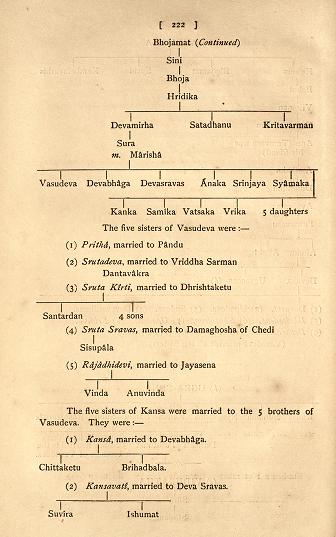Shini

Shini (शिनि) (Sini) was Chandravanshi King born in the third generation of Maharaja Vrishni. The descendants of Shini are known as Shinivanshi or Saineyas .
In Mythology
Vir Satyaki in Mahabharata was of Shinivanshi.[1] Satyaki, also called Yuyudhana, is a powerful warrior belong to the Yadava-Vrishni dynasty of Lord Krishna, in the Mahabharata epic.
Satyaki is devoted to Krishna and his best friend Arjuna, with whom he trained under Drona in military arts. He strongly and passionately favors the cause of the Pandavas over the Kauravas in the Kurukshetra War. Satyaki accompanies Krishna to the Kuru capital with Krishna as the emissary of peace which is ridiculed and turned down by the sons of Dhritarashtra.
History
Hukum Singh Panwar[2] has given the ancestry of Bharatpur rulers starting from 1. Yadu. Shini is at S.No. 38 and Krishna at S.No. 43 as under[3]:
34. Andhaka → 35. Bhajmana → 36. Viduratha → 37. Shura → 38. Shini → 39. Bhoja → 40. Hardika → 41. Devamidha → 42. Vasudeva → 43. Krishna → 44. Pradyumna
According to H. W. Bellew the Sini were foreign settlers in Afghanistan. H. W. Bellew [4] writes that gradually as the Khattaks increased in strength, they extended northward, and pressing aside the Orakzai and Afridi to the higher hills, took possession of all the Indus riverine up to the Kabul river, and even advanced across it, as before mentioned, into the Yusufzai country. In their advance they absorbed several small communities of foreign settlers, such as the Mughalki and Sini (Mughal or Mongol, and Chinese), whom they include in their Bulac division, and the Jalozai, Dangarzai, and Oriyakhel, whom they include in their Teri division.
H.A. Rose[5] in the History of Khattaks writes that ...Another Mughal defeat was the result, and Khushhal was enabled to make another attempt on Kohat, but deserted by the Sinis and Mushaks as before he was defeated and wounded in 1675.
Sini River
According to Sir H. M. Elliot[6]The Chach-náma mentions it in three different passages, at least, if Kandhála in the last reference be meant, as seems probable, for that place. If we are to put faith in the first passage (p. 152), there would be no need for further enquiry, as it is distinctly mentioned thus:-"Kandábel, that is, Kandahár." But it may be shown that this identification cannot possibly be admitted, for Chach reaches the place through the desert of Túrán (a province of which Kusdár was the capital),2 on his return from Armá-bel to Alor. He straitened the garrison by encamping on the river Síní, or Sibí, and compelled them to agree to the payment of one hundred horses from the hill country, and a tribute of 100,000 dirhams. Here the name of the river, and the position, put Kandahár out of the question, and we can only regard the passage as the conjecture of some transcriber, interpolated by mistake from the margin into the text.
The real fact is, that Kandábel3 can scarcely be any other place than the modern Gandáva, and we shall find, with this single exception, that all the other passages where its name occurs sufficiently indicate that as the position. Indeed, it is probable that this very instance lends confirmation to this view, for the Síní river seems to be no other than the Síbí, now called the Nárí, but flowing under the town of Síbí, and, during the floods, joining the Bolán river, into which the hill-streams, which surround and insulate Gandáva, disembogue themselves. The river which runs nearest to Gandáva is now called the Bádra.
Jat clans descended from Shini
External links
Reference
- ↑ Dr Mahendra Singh Arya, Dharmpal Singh Dudi, Kishan Singh Faujdar & Vijendra Singh Narwar: Ādhunik Jat Itihasa (The modern history of Jats), Agra 1998
- ↑ The Jats:Their Origin, Antiquity and Migrations/Appendices/Appendix No.1
- ↑ Yadu Vamsavali of Bharatpur given by Ganga Singh in his book 'Yadu Vamsa', Part 1, Bharatpur Rajvansa Ka Itihas (1637-1768), Bharatpur, 1967, pp. 19-21
- ↑ The Races of Afghanistan/Chapter IX, p.87
- ↑ A glossary of the Tribes and Castes of the Punjab and North-West Frontier Province By H.A. Rose Vol II/K,p.529
- ↑ The History of India, as Told by Its Own Historians/Note (A).- Geographical,p.385
- ↑ Dr Mahendra Singh Arya, Dharmpal Singh Dudee, Kishan Singh Faujdar & Vijendra Singh Narwar: Ādhunik Jat Itihas (The modern history of Jats), Agra 1998, p. 282
- ↑ The Jats:Their Origin, Antiquity and Migrations/Appendices/Appendix No.1
Back to The Ancient Jats

